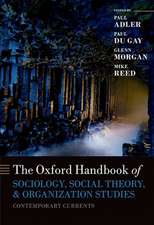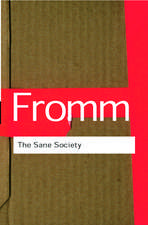A Hospice in Change: Applied Social Realist Theory: Critical Realism: Interventions (Routledge Critical Realism)
Autor Martin Lipscomben Limba Engleză Hardback – 26 sep 2013
It is argued that differential morphogenesis can be identified between structures (social and cultural) and agents (individual and group) at an independent healthcare charity in southern England. A Hospice in Change connects theory and philosophy with concrete research practice to provide a worked example of Margaret Archer’s realist social theory.
Preț: 541.62 lei
Preț vechi: 1065.16 lei
-49% Nou
Puncte Express: 812
Preț estimativ în valută:
103.64€ • 108.50$ • 85.75£
103.64€ • 108.50$ • 85.75£
Carte tipărită la comandă
Livrare economică 07-21 aprilie
Preluare comenzi: 021 569.72.76
Specificații
ISBN-13: 9780415622516
ISBN-10: 0415622514
Pagini: 208
Ilustrații: 18 b/w images, 2 tables and 18 line drawings
Dimensiuni: 156 x 234 x 18 mm
Greutate: 0.46 kg
Ediția:New.
Editura: Taylor & Francis
Colecția Routledge
Seria Critical Realism: Interventions (Routledge Critical Realism)
Locul publicării:Oxford, United Kingdom
ISBN-10: 0415622514
Pagini: 208
Ilustrații: 18 b/w images, 2 tables and 18 line drawings
Dimensiuni: 156 x 234 x 18 mm
Greutate: 0.46 kg
Ediția:New.
Editura: Taylor & Francis
Colecția Routledge
Seria Critical Realism: Interventions (Routledge Critical Realism)
Locul publicării:Oxford, United Kingdom
Cuprins
Contents: 1. Introduction 2. Margaret Archer’s Morphogenetic-Morphostatic Methodology 3. Realist social theory applied 4. Study findings 5. Conclusion Appendices: A. Interview Guide B. Pre-coding interview summary A:a C. Pre-coding interview summary B:a D. Interview coding process – A:a E. Interview coding process – B:a F. Template A:a G. Template B:a H. Master template
Notă biografică
Martin Lipscomb is Senior Lecturer at the University of the West of England.
Descriere
A Hospice in Change: Applied Social Realist Theory reports upon a study into aspects of the ways in which structural and organisational developments, professional cultures and ‘bedside’ or patient focused clinical practice interact within a single UK institution. While the findings of this study are time and context specific, the events and social processes being described may nonetheless resonate closely with the experience of healthcare practitioners at other hospices both within and without the UK. The work examines themes and ideas that hospice and palliative care practitioners, as well as those involved or interested more broadly in ‘end of life issues’, may find relevant.
It is argued that differential morphogenesis can be identified between structures (social and cultural) and agents (individual and group) at an independent healthcare charity in southern England. A Hospice in Change connects theory and philosophy with concrete research practice to provide a worked example of Margaret Archer’s realist social theory.
It is argued that differential morphogenesis can be identified between structures (social and cultural) and agents (individual and group) at an independent healthcare charity in southern England. A Hospice in Change connects theory and philosophy with concrete research practice to provide a worked example of Margaret Archer’s realist social theory.
























